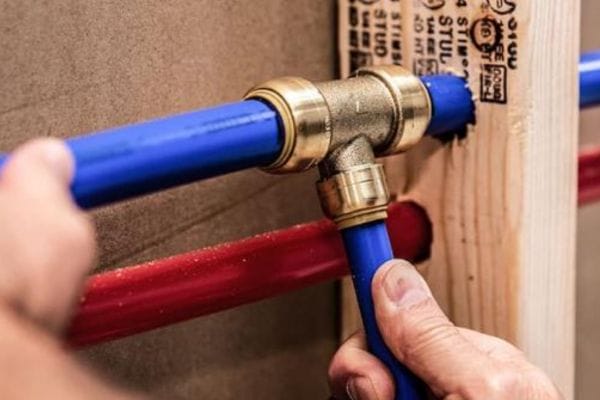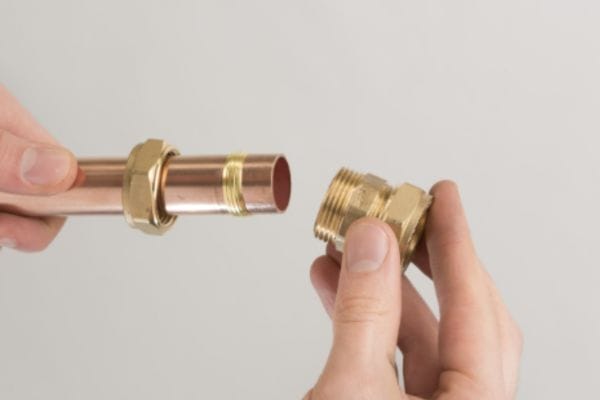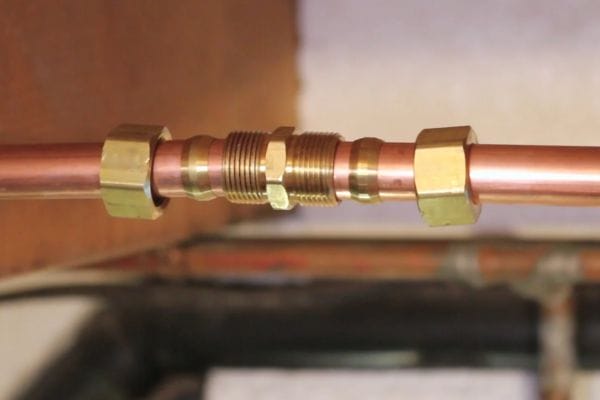Shark Bite fittings are push-to-connect plumbing solutions that provide a quick and easy way to join pipes without the need for special tools, adhesives, or soldering. In contrast, compression fittings are a more traditional plumbing option that require a nut, ferrule, and fitting body to form a tight, leak-proof seal around rigid pipes, such as copper or steel. When selecting a fitting, it’s essential to consider factors such as pipe material, installation ease, cost, and long-term maintenance needs to determine the best choice for your specific plumbing project.
Shark Bite Fittings: The Quick and Easy Solution
How Shark Bite Fittings Work
Push-to-Connect Mechanism: Shark Bite fittings utilize a push-to-connect design that allows for quick and effortless installation. Simply insert the pipe into the fitting, and the internal mechanism automatically grips the pipe to create a secure connection.
Internal Seals: These fittings contain an O-ring that provides a watertight seal as the pipe is pushed in. Additionally, a brass or stainless steel ring holds the pipe in place, preventing movement or leaks under pressure.
No Tools or Special Equipment Needed: One of the standout features of Shark Bite fittings is that they require no tools for installation. No need for soldering, crimping, or threading. This makes them ideal for DIY projects or repairs in situations where time and ease are critical.
Versatile Compatibility: Shark Bite fittings are designed to work with a wide range of pipe materials, including copper, PEX, CPVC, and even some types of PVC. This versatility makes them a go-to solution for many plumbing jobs.
Key Advantages of Shark Bite Fittings
Quick Installation: As mentioned, the main benefit of Shark Bite fittings is how fast and easy they are to install. With no need for special tools or professional expertise, you can have your pipes connected in seconds.
Leak-Proof Connections: The internal O-ring and gripping mechanism ensure a tight, leak-proof seal every time, offering peace of mind that the fitting will not fail under pressure.
No Heat Required: Unlike traditional soldering, which requires a flame and safety precautions, Shark Bite fittings require no heat for installation. This makes them much safer and more convenient, particularly for plumbing tasks in confined spaces.
Removable and Reusable: In many cases, Shark Bite fittings can be removed and reused without causing damage to the pipes, allowing for flexibility if changes are needed down the line.
Ideal for Tight Spaces: Due to the simple push-to-connect design, these fittings can be used in areas that would be challenging for other types of fittings, such as under sinks or in narrow cabinets.
Cost-Effective for DIY Projects: Shark Bite fittings might be slightly more expensive upfront than compression fittings, but they save you time and money by eliminating the need for professional installation or complex tools.

Common Applications for Shark Bite Fittings
Residential Plumbing: Shark Bite fittings are widely used in residential plumbing, particularly for repairs, upgrades, and DIY installations. They’re perfect for connecting new PEX pipes to existing copper or CPVC lines.
Emergency Repairs: In situations where a pipe bursts or leaks unexpectedly, Shark Bite fittings provide a fast and reliable temporary solution. Their quick installation makes them ideal for emergency repairs without the need for extensive downtime.
Water Heater Connections: These fittings are commonly used to connect water heaters to piping systems because they’re easy to install in tight spaces and don’t require any heat, which is a major advantage near sensitive equipment.
Under-Sink Plumbing: The compact size and ease of installation make Shark Bite fittings ideal for tight spaces like under kitchen sinks or bathroom vanities. They’re often used for connecting faucets, garbage disposals, and dishwashers to the plumbing system.
HVAC and Radiator Systems: Shark Bite fittings are also used in HVAC systems and radiator installations, where reliability and easy access for maintenance are key.
Outdoor Plumbing: They’re a great solution for outdoor irrigation systems, garden fountains, or hose bib connections, as they can easily withstand different environmental conditions.
Shark Bite Fitting Installation: A Step-by-Step Guide
Step 1: Measure and Cut the Pipe Begin by measuring and cutting your pipe to the correct length. Make sure the pipe is cut cleanly, with no burrs or rough edges that might interfere with the fitting. A pipe cutter or hacksaw can be used for this.
Step 2: Deburr the Pipe (if needed) If the pipe is copper or metal, use a deburring tool to smooth out any sharp edges. This is crucial for ensuring a secure and leak-free connection.
Step 3: Insert the Pipe into the Shark Bite Fitting Simply slide the pipe into the Shark Bite fitting. The internal O-ring and stainless steel gripping teeth will automatically secure the pipe in place. Push the pipe until it is fully inserted into the fitting, ensuring it is seated correctly.
Step 4: Check the Connection Once the pipe is inserted, pull on it gently to make sure it is firmly connected. A properly installed Shark Bite fitting should not be able to slide off the pipe.
Step 5: Turn on the Water Supply Once the fitting is in place, turn on the water supply to check for any leaks. If there are no leaks, the connection is complete and secure. If you notice any leaks, you may need to remove and reinstall the fitting, ensuring the pipe is properly inserted.
Step 6: Removing the Fitting (if necessary) If you need to remove a Shark Bite fitting, use a special removal tool, which is designed to disconnect the fitting from the pipe without causing damage. Simply slide the tool around the fitting and release the grip.
Compression Fittings: The Traditional Plumbing Choice
How Compression Fittings Work
Mechanism of Action: Compression fittings operate by using a compression nut, ferrule (a small metal ring), and a fitting body to create a tight, secure seal around the pipe. When the compression nut is tightened, it compresses the ferrule onto the pipe, forming a leak-proof joint. The ferrule grips the pipe, and the nut secures it in place.
Application on Rigid Pipes: Compression fittings are ideal for rigid pipes, such as copper, steel, or sometimes plastic pipes. The connection formed is durable and resistant to high pressure, making it suitable for a variety of plumbing systems.
No Need for Soldering or Welding: Unlike other traditional fittings that require soldering or welding, compression fittings do not require heat, making them safer and easier to use, especially for areas where using heat could be difficult or dangerous.
Key Advantages of Compression Fittings
Reliable, Leak-Proof Seals: Compression fittings are known for their durable, leak-proof seals that provide long-lasting, strong connections. They are less prone to failure than some other fitting types, offering peace of mind for both residential and commercial plumbing systems.
Cost-Effective: While the initial cost of compression fittings might be lower than Shark Bite fittings, they can be more affordable in the long term, especially when used in large-scale plumbing projects. Their materials, such as brass or stainless steel, offer great value for the price.
Ideal for Permanent Installations: Compression fittings are highly reliable and ideal for permanent installations, especially in plumbing systems that need to stand the test of time. They’re commonly used in water lines, gas lines, and irrigation systems due to their stability and resistance to corrosion.
Easy to Repair and Maintain: Compression fittings are easy to maintain and replace if necessary. If a fitting starts leaking, it can be tightened or replaced without requiring complex tools or skills.
Wide Range of Applications: These fittings are versatile and commonly used for both residential and commercial applications, such as connecting water supply pipes, faucets, water heaters, and irrigation systems.

When Should You Use Compression Fittings?
Permanent Plumbing Installations: Compression fittings are best for situations where a long-lasting and permanent connection is needed. They are ideal for systems that will not need frequent adjustments or removals, such as water supply lines or gas connections.
Use with Rigid Pipes: Compression fittings are designed to work primarily with rigid pipes like copper or steel. They are not the best choice for flexible or PEX pipes, as they work best when the pipe is not prone to movement.
When Heat is Not an Option: If you’re working in a space where you cannot safely use heat (for soldering or brazing), compression fittings are an excellent alternative, as they don’t require any heat during installation.
High-Pressure Systems: Compression fittings are known for their ability to handle high-pressure systems without compromising the seal. They are perfect for situations where the plumbing needs to withstand heavy usage and pressure, such as industrial plumbing or commercial heating systems.
Repairing Leaks in Existing Plumbing: If an existing connection starts leaking, using compression fittings to repair the joint is a fast and effective method. You can replace or tighten the fitting without having to replace entire sections of pipe.
Compression Fitting Installation: Tips and Techniques
Step 1: Prepare the Pipe Begin by ensuring the pipe is cut cleanly and free of any burrs. Use a pipe cutter for precise cuts, and if needed, a deburred tool to smooth out the pipe edges. This ensures the compression fitting can seal tightly without obstruction.
Step 2: Slide the Nut and Ferrule onto the Pipe Before inserting the pipe into the fitting, slide the compression nut and ferrule (a small ring) onto the pipe. The ferrule should be placed closest to the pipe end, with the nut following it.
Step 3: Insert the Pipe into the Compression Fitting Next, insert the pipe into the fitting body. Make sure the pipe is fully inserted into the fitting, ensuring that the ferrule is seated properly inside the fitting.
Step 4: Tighten the Compression Nut Tighten the compression nut onto the fitting. Use a wrench to ensure it is secure, but be careful not to overtighten, as this can damage the fitting or the pipe. The nut should be snug but not excessively tight.
Step 5: Check for Leaks Once the fitting is installed, turn on the water or gas supply and check for any leaks. If the fitting is installed correctly, there should be no water leakage. If leaks occur, tighten the nut slightly or replace the ferrule if needed.
Common Misconceptions About Shark Bite and Compression Fittings
Are Shark Bite Fittings Really Leak-Proof?
The Reality of Leak Resistance: One common misconception about Shark Bite fittings is that they are not as reliable as traditional plumbing connections and are prone to leaks. In fact, Shark Bite fittings are designed with an internal O-ring and gripping teeth, which create a secure, leak-free connection when installed properly. However, leaks can occur if the fitting is improperly installed, such as if the pipe isn’t fully pushed into the fitting or if the pipe is damaged.
Proper Installation is Key: To ensure a leak-proof seal, the pipe must be clean and free of debris, and the fitting must be fully engaged with the pipe. If installed correctly, Shark Bite fittings provide long-term durability and reliability, even in high-pressure systems.
Considerations for Older Pipes: While Shark Bite fittings work well with most pipes like PEX, copper, and CPVC, issues may arise when used with older, corroded pipes. In such cases, it’s essential to inspect the pipe’s condition before installation to ensure the fitting will make a proper seal.
Do Compression Fittings Require Special Tools?
Basic Tools Needed: Another misconception is that compression fittings require specialized, expensive tools to install. In reality, the installation of compression fittings typically only requires basic tools such as a wrench or adjustable spanner to tighten the compression nut. Unlike soldering, there is no need for heat or welding equipment.
Proper Pipe Preparation: While the installation is simple, it’s crucial to properly prepare the pipe before inserting it into the fitting. This includes cutting the pipe cleanly and deburring it to ensure a smooth surface for the ferrule to compress onto. A pipe cutter and deburred tool are recommended, but they are not specialized tools—just basic plumbing tools that most plumbers or DIY enthusiasts already have on hand.
No Need for Welding or Soldering: Compression fittings provide a tool-free alternative to more complicated connection methods, like welding or soldering, making them accessible to a broader range of people, from professional plumbers to DIYers.
The Myth of “Temporary” Shark Bite Fittings
Shark Bite Fittings Are Permanent: One of the most persistent myths about Shark Bite fittings is that they are meant to be temporary solutions. While it’s true that some plumbers consider them a quick fix, Shark Bite fittings, when installed correctly, can last for years without any issues. They are often used in emergency repairs due to their speed and ease of installation, but they are also a reliable, long-term option for many types of plumbing systems.
Durability and Long-Term Use: Shark Bite fittings are built to handle the same pressures and conditions as traditional plumbing connections. In fact, they are code-compliant in most areas for permanent installations. With brass and stainless steel construction, these fittings are resistant to corrosion and wear, making them just as durable as compression fittings when used properly.
Why the “Temporary” Label Sticks: The perception of Shark Bite fittings as “temporary” may stem from their association with DIY plumbing projects or quick fixes, which often give the impression that the fitting will not last as long as a professionally installed compression fitting or soldered connection. However, when applied correctly and for the right type of project, Shark Bite fittings provide a permanent, reliable connection that can withstand years of use.
Choosing the Right Fitting for Your Project
Factors to Consider: Pipe Material, Location, and Budget
Pipe Material: The type of pipe you’re working with plays a major role in choosing the right fitting. Shark Bite fittings are compatible with PEX, copper, CPVC, and some types of PVC, making them versatile for a variety of projects. However, they are particularly ideal for PEX piping, which is flexible and easy to connect with Shark Bite’s push-to-connect design. Compression fittings, on the other hand, are best suited for rigid pipes, especially copper and steel, and are commonly used in gas lines and water supply lines.
Location of Installation: Consider the location where the fitting will be installed. If you’re working in tight spaces or need to complete a plumbing project quickly, Shark Bite fittings are a great choice. Their tool-free installation and flexibility make them ideal for situations like under-sink installations or areas with limited space. If the project requires more time and effort, or involves a permanent installation in a visible or high-pressure area, compression fittings may be more appropriate due to their robust, long-lasting seal.
Budget: Cost is an important consideration when choosing your fitting. Shark Bite fittings tend to be more expensive than compression fittings due to their advanced design and ease of installation. If you’re working on a larger-scale project or have a tight budget, compression fittings might be the more cost-effective solution. However, if time is a critical factor and you need to save on labor costs, Shark Bite fittings’ easy installation could be worth the extra investment.
When to Choose Shark Bite Fittings for DIY Plumbing
Ease of Installation: One of the major selling points of Shark Bite fittings is their DIY-friendly nature. Since they don’t require any specialized tools, soldering, or threading, these fittings are perfect for homeowners or first-time DIY plumbers. Whether you’re replacing a leaky pipe or installing a new water line, Shark Bite fittings can help you get the job done quickly and efficiently with minimal experience.
Tight or Hard-to-Reach Areas: If you’re working in an area with limited space, such as under a sink or in a cramped utility closet, Shark Bite fittings can be a lifesaver. The compact size and easy-to-use design mean you can quickly install fittings without worrying about maneuvering large tools or heating equipment. This is especially helpful for tight spots where using a wrench or soldering torch would be impractical.
Temporary Repairs and Emergencies: Shark Bite fittings are ideal for emergency repairs or temporary fixes, as they allow you to restore water flow or complete a project without delay. For example, if a pipe bursts and you need to fix it quickly, a Shark Bite fitting can be installed within minutes, giving you time to plan a more permanent solution. This makes them highly recommended for emergency plumbing situations.
Flexibility with PEX Pipes: Shark Bite fittings are particularly well-suited for PEX pipes, which are often used in DIY plumbing projects due to their flexibility and ease of installation. If you’re working with PEX, Shark Bite fittings will make the job faster and easier without the need for complicated tools.

Why Compression Fittings Might Be Best for Professional Plumbing Jobs
Permanent, Reliable Connections: While Shark Bite fittings are ideal for quick DIY installations, compression fittings are preferred by professional plumbers for their durability and reliability in long-term plumbing systems. Compression fittings provide a strong, permanent seal that can withstand high pressure, making them a great choice for main water lines, gas lines, and areas where safety and dependability are essential.
High-Pressure Systems: Compression fittings are highly effective in high-pressure systems, such as those used in industrial plumbing, heating systems, or large residential systems. Their compression nut and ferrule mechanism makes them capable of withstanding higher pressures without compromising the integrity of the connection. Professionals often rely on compression fittings in these scenarios to ensure a secure and safe installation.
Regulations and Codes: In some regions or for certain plumbing projects, building codes or plumbing regulations may require the use of compression fittings for specific types of installations. Professionals are generally more aware of these regulations and may choose compression fittings to ensure compliance with local building codes.
Suitable for Various Pipe Materials: While Shark Bite fittings are versatile, compression fittings are often preferred when working with more rigid pipes, like copper, steel, or stainless steel. Professional plumbers who work with these materials will typically turn to compression fittings for their proven reliability and effectiveness in forming secure, long-lasting joints.
Long-Term Maintenance: Compression fittings tend to require less frequent maintenance or replacement compared to Shark Bite fittings, making them a preferred choice for systems that need to function reliably over time. Compression fittings are also more widely regarded as suitable for permanent installations, as they do not rely on the same O-ring and gripping mechanism as Shark Bite fittings, which some may view as less permanent.
Conclusion
Choosing between Shark Bite fittings and compression fittings ultimately depends on your specific plumbing needs. Both types of fittings have their place in the world of plumbing, and the right choice depends on factors like pipe material, installation complexity, budget, and project duration. By understanding the strengths and limitations of each, you can confidently choose the best fitting for your specific situation, ensuring a secure and lasting plumbing connection.
FAQ
Can Shark Bite Fittings Be Used with PVC Pipes?
Yes, Shark Bite fittings can be used with PVC pipes, along with PEX, copper, and CPVC pipes. Just make sure you’re using the correct Shark Bite fitting designed for PVC.
Are Compression Fittings Compatible with PEX Pipes?
No, compression fittings are typically not recommended for PEX pipes. They work best with rigid materials like copper, steel, and CPVC.
Can Shark Bite Fittings Be Reused?
Yes, Shark Bite fittings can be removed and reused, as long as the fittings and pipes are in good condition. Use a Shark Bite removal tool for easy disconnection.
Do Compression Fittings Require Special Tools?
Compression fittings do not require special tools, but you will need basic plumbing tools like a wrench and pipe cutter to properly install them.
Are Shark Bite Fittings Permanent?
Yes, Shark Bite fittings can be permanent when installed correctly, though they are often considered temporary in emergency repairs or for DIY projects due to their ease of installation.
How Long Do Compression Fittings Last?
Compression fittings can last for decades when properly installed, as long as the system is well-maintained and the fitting is not over-tightened or exposed to damage.





